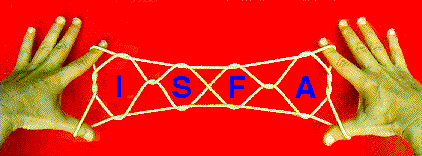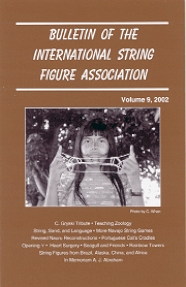Volume 9 (2002): 366 pages - Table des Matières
Edité par - Mark A. Sherman, Pasadena, California
Rédacteurs Associés - Joseph D'Antoni, Queens, New York; Myriam Namolaru, Haifa, Israel;
Belinda Holbrook, Davenport, Iowa; Stephan Claassen, Best, Netherlands.
Comité de Rédaction - Hiroshi Noguchi, Tokyo, Japan; Philip Noble, Inverness, Ecosse
Le Bulletin de l'Association Internationale du Jeu de Ficelle (BISFA) est une publication savante
présentant des documents originaux qui fait progresser notre compréhension et renforce
notre plaisir des jeux de ficelle. BISFA est publié annuellement, en septembre, par ISFA Press
(Pasadena, Californie). BISFA remplace le Bulletin de l'Association des Jeux de Ficelle,
(Toky Nippon Ayatori Kyokai), qui a été publiée en 19 volumes (1978-1993).
Les traductions proposées ne comprennent pas les illustrations et photos du texte original.
J'ai traduit ces textes pour vous donner un aperçu de la qualité et de la richesse de
ces publications.
Tribute
- Une Conversation avec Camilla Gryski: la "Lady Ficelle" du Canada , par Mark Sherman, Pasadena, Californie, (pages 1-54) - Cet article présente une biographie de Camilla Gryski, une étude de ses neuf livres publiés, plus la copie de l'interview réalisée en avril 2001.
Commentary
- " Très Ressemblant à une Lamproie": Comment les Jeux de Ficelle Ajoutent une Valeur de Plaisir aux Cours de Science , par Michael Pollock, Calgary, Alberta, Canada, (pages 55-68) - Dans le passé les conteurs employaient les jeux de ficelle pour rehausser leurs récits. Aujourd'hui le professeur de zoologie Michael Pollock emploie des jeux de ficelle pour animer ses cours plutôt arides, de taxinomie des vertébrés. Les étudiants apprécient les efforts qu'il fait pour capter leur attention. Sa stratégie est exposée brièvement dans l'essai suivant.
- String Figures, Sand Paintings, and Language -- Are they linked?, by Sam Cannarozzi-Yada, Parcieux, France, (pages 69-72) - In this short essay the author examnines parallels between string figures, Navajo sandpaintings, Vanuatu ululan (geometric drawings traced in the sand), and mandalas (meditative sand paintings) made by Tibetan monks. Language parallels are also examined.
Research Reports
- String Games of the Navajo, Part 2: Supplemental Notes and Additional Figures, by Mark Sherman, Pasadena, California, and Will Wirt, Port Angeles, Washington, (pages 73-150) - In our last article we described 56 string figures and 4 string tricks gathered among the Navajo Indians of Arizona during the winter of 1999-2000. The article also included 14 string figures published by Jayne nearly a century ago. In this article we offer additional information gathered during the winter of 2001. This information includes a table that summarizes the prevalence of each game at 12 different locations on the reservation (5 of which were surveyed for the first time in 2001), alternative titles for many of the previously gathered figures, and 41 new games, most of which are variations of previously collected games. This article also includes a highly detailed analysis of subtle differences in technique observed among 50 informants who were asked to perform figures from the standard Navajo repertoire. The analysis suggests that there is no single "correct" way to form many of the figures.
- Reru: Jeux de Ficelle des Indiens Karajá Brésiliens , par Chang Whan, Niterói RJ, Brésil, (pages 151-185) - Cet article rapporte les résultats des recherches conduites par l'auteur sur l'activité consistant à réaliser des jeux de ficelle observée parmi les indiens Karajá du Brésil entre les années 1996 et 1998, dans le cadre des matières obligatoires nécessaires pour un M.A. degree en Anthropologie de Art à l'Université Fédérale de Rio de Janeiro. En tout 50 jeux de ficelle ont été photographiés. Des méthodes pour réaliser 28 d'entre eux, sont présentées dans cet article.
- Xema’eדwa:String Games among the Tapirapי Indians of Brazil, by Luiz Gouvךa de Paula and Eunice Dias de Paula, Goiגnia, Brazil, (pages 186-202) - In this article the authors document 40 string figures gathered among the Tapirapי Indians of Mato Grosso, Brazil, during April of 1986. For each design the authors were able to secure a mounted specimen and record the native name, but no methods of manufacture were obtained. However, many of the designs are identical or similar to designs collected among the neighboring Karajב Indians, for which the method of manufacture is known (see the preceding article in this volume).
- Jeux de ficelle Yup’ik , par David Nicolai, Anchorage, Alaska, (pages 203-234) - Les anthropologues qui ont visité l'Alaska au début du vingtième siècle étaient fascinés les jeux de ficelle complexes que leur ont montrés les habitants Yup’ik et Inupiaq. Les distractions de la vie moderne ont fait que les techniques nécessaires à la réalisation de ces figures ont souvent été perdues. Heureusement, quelques familles ont conservé leurs traditions vivantes en transmettant leurs connaissances aux plus jeunes générations. Dans cet article David Nicolai décrit 42 jeux de ficelleYup’ik appris de son père et sa grand-mère (J'ai traduit presque toutes les figures ).
- More String Figures from China, by Will Wirt, Port Angeles, Washington, (page 235-240) - In 1997, Will Wirt collected 28 string figures and 4 tricks while visiting the Yunnan Province and Beijing Municipality in China and the city of Lhasa in Tibet. His collection, published in volume 5 of this journal, provided the West with its first glimpse of string games from this region. In this article the author describes three additional fiugres he collected on a return visit in 2001.
- Some String Figures from Modern Africa, by Axel Reichert, Bad Oldesloe, Germany, (pages 241-248) - In this article the author describes methods for making several string figures and tricks he gathered in the African pavilion at EXPO2000, a world exposition held in Hannover, Germany two years ago. His informants were from Nigeria, Mauretania, Mali, and Madagascar. Most are identical or closely related to African figures first collected over 60 years ago.
- Revised Reconstructions for some Nauruan String Figures, by John Kean, Lincoln, New Zealand, Joseph D’Antoni, Queens, New York, Mark Sherman, Pasadena, California, and Yukio Shishido, Kyoto, Japan, (pages 249-261) - We present several new constructions for the Nauruan string figures Domaneab (Meeting House), Cantilever Jetty, and Aom (Hermit Crab). While the former are the more complicated designs, the latter presents perhaps the greater challenge to those seeking reconstructions. For, although we present no less than six different reconstructions for Aom, detailed analysis suggests that we cannot be sure which method is best, nor even if we have reconstructed the correct figure. The Nauruan string figures continue to surprise and challenge, almost a century after they came to the attention of the Western world.
- Cat’s Cradle in Portugal, by Paulo Escudeiro, Cacem, Portugal, (pages 262-284) - Cat’s Cradle, a two-player series that apparently originated in China or Japan, is now enjoyed worldwide. However, the sequence of designs often varies from country to country. In this article the author describes seven different sequences he observed among school children in Lisbon. According to the author new designs are often created spontaneously. Of special note are several asymmetrical designs not reported previously.
- Est-ce que ce Jeu de Ficelle est Possible? , par Joseph D’Antoni, Queens, New York, (pages 285-293) - Cet article explore une méthode pour altérer les croisements de ficelles d'un jeu fini, pour obtenir un nouveau motif, puis tester le nouveau motif pour voir s'il peut vraiment être construit, à partir d'une simple ficelle en boucle.
- Opening ∀, by Joe Ornstein, New York, New York, (pages 294-306) - Opening A is the most ubiquitous opening in all the string figure world. Its simplicity and symmetry on the fingers has a natural appeal from which flows many a string figure. But in a strange way Opening A can sometimes stifle creativity. Use Opening A too much, and the mind can become locked into thinking about finger manipulations and string movements in limited ways. Thinking outside the box becomes difficult. New openings give birth to new string realities to explore with ten fingers, two hands, and a loop of string. Antipodal A is just such an opening.
- Using String Figures to Teach Math Skills - Part 6: Fun with Opening ∀, by James R. Murphy (inoli), New York, New York, (pages 307-319) - In previous articles the author has explored various string figure "systems" suitable for teaching math students how to think logically and better comprehend various fundamental math concepts such as reciprocals, additive inverses, matrices, iterations, generalized formulas, chirality, asymmetry. By learning to create and symbolically notate new string figures students overcome their math shyness. In this playful article the author exhibits his acquired skills by showing how a new string figure opening can be systematically manipulated to create a series of beautiful new designs. Several net figures with a "heart" embedded in the web are of special interest.
Modern String Figures
- Seagull, Water Bucket, and Fawn String Figures, by Kazuo Kamiya, Saitama, Japan, (pages 320-344) - 'Seagull', 'Two Men Carrying Water Buckets', and 'Two Fawns' are traditional Inuit string figures whose methods of construction are related. In this article the author introduces new methods for making each of them plus 18 variations. The variations represent various animals such as eagles, dogs, rabbits, and giraffes. All the figures in this article are described using a shorthand notational system devised by the author.
- Tours Arc-en-Ciel d'Hanoi : Une version à plusieurs ficelles en boucle d'un jeu de ficelle récemment inventé par Tetsuo Sato, Kumamoto, Japon, (pages 345-349) 'Les Tours d'Hanoi' est un jeu de ficelle moderne inventé par Frank Oteri of New York. Il ressemble à un puzzle mathématique classique du mem nom. Dans cet article, l'aiteur montre comment construire une version multicolore de cette surprenante nouvelle figure en employant de multiples ficelles en boucle..
Obituary
- In Memoriam Alexander Johnston Abraham (1915-2002), par Sally Abraham, Vancouver, Colombie Britannique, Canada, (pages 350-351) - La vie d'un éminent auteur du jeu de ficelle est récapitulée par sa fille..
Book Reviews - by Joseph D'Antoni, Mark Sherman, and Axel Reichert (pages 352-357)
- He Whai: Old and New String Figures from Aotearoa New Zealand, by Briar O’Connor and Libby Patterson.
- For Children: How to Make String Figures, by Hen (Hsian) Lung Yu (written in Chinese).
- Now you see it…String Games and Stories - Book 2, by Michael Taylor.
- Fadenspiele sind mehr!: Fadenfiguren spielen und Geschichten erzהhlen (String Games are More!: String Figures to Play and Stories to Tell), by Lothar Walschik (ABOINUDI)
- The String Figures of Nauru Island, by Honor Maude with members of the International String Figure Association. Second edition, revised and expanded.
Errata (pages 358-359)
- The String Figures of Nauru Island, 2nd Edition, 1st press run (late 2001) - Many of the errata listed here were corrected in the second press run (mid-2002). Unfortunately the first press run (mid-2001) suffered from numerous printing and computer errors, most of which were corrected in the second press run (early 2002). However, a significant number of copies from the first press run were sold before the errors were noticed. If the last page of your copy is blank, it is from the second press run and you need not worry.
Letters to the Editor (pages 327-334)
- L' Extension Négligée - John Kean. Beaucoup de jeux de ficelle sont étendus sur les mains entre une paire de ficelles "cadre", qui reposent typiquement sur le côté voisin des pouces et le côté lointain des petits doigts avant l'extension. Dans cette lettre, l'auteur attire notre attention sur une technique inusitée employée par les artistes maori du jeu de ficelle (en réalisant le motif nommé Kotiro-Punarua pour stabiliser les lignes du cadre et optimiser la symétrie du motif.
- Belize, Please - David Titus. Figures and tricks observed on a recent visit to Belize in Central America are described.
- Diamonds from South Africa - David Titus. Figures and tricks observed on a recent visit to South Africa are described.
- Quarks & Super Strings: Actions and re-Actions - Sam Cannarozzi Yada. In the 8th Bulletin of the ISFA (2001), I had whimsically written an article proposing comparisons between string figures and quantum physics. To my delighted surprise, lo and behold, I received encouragement for my musing from not only an ISFA member, but a member who is as well a scientist of high atmosphere physics AND the son of one of the most prestigious precursors of string figure collecting and research: Dr. Henry Rishbeth, son of Kathleen Haddon.
- Kiwi - One or Two? - Carey C.K. Smith. Whether or not this string figure from New Zealand represents one or two Kiwis is debated.
- The Saw I Saw in Greece - Yukio Shishido. A string figure photographed on the Island of Rhodes in 1978 is compared to a similar figure photographed in Athens in 1951.
Ajouter un commentaire







